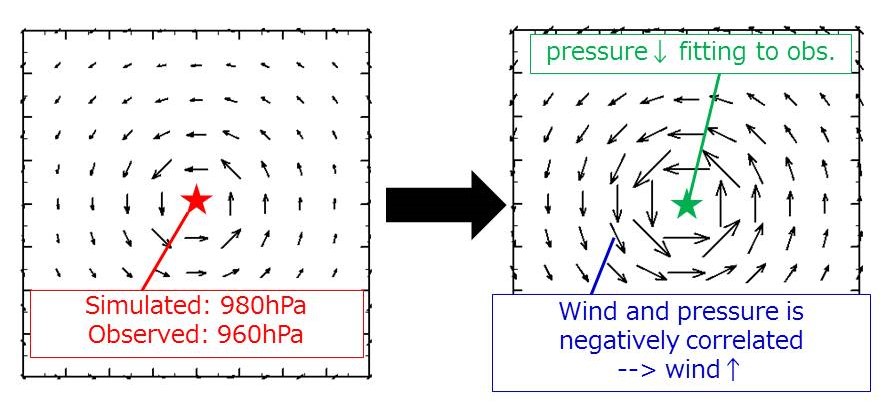Kosuke ItoSevere Storm and Extreme Weather, Disaster Prevention Research Institute, Kyoto University |
|
Tropical cyclone
Three-dimensional Fujiwhara effect

When two tropical cyclones (TCs) coexsit, the wind associated with one TC makes the other TC move cyclonically and they get closer to each other. This effect has been known as the Fujiwhara effect in honor of Dr. Sakuhei Fujiwhara. We showed that a system of two TCs induces vertical wind shear in each TC, which can subsequently modify the tracks of these TCs through asymmetric diabatic heating for the first time. The direction of deviation associated with the asymmetric heating is clockwise and repelling with respect to the midpoint of two TCs. [QJ paper] [MWR paper]
Prediction with an atmosphere-ocean coupled high-resolution model

Sea surface temperature decreases dramatically on a time scale of several hours to a few days due to shear-induced entrainment at the base of the ocean mixed layer and the oceanic Ekman pumping according to the passage of tropical cyclones. Therefore, it is very important to develop an atmosphere-ocean coupled high-resolution model in terms of predicting tropical cyclone intensity. We have shown that our model can improve a tropical cyclone intensity forecast by about 10-40% relative to the global model used in Japan Meteorological Agency. A data assimilation system based on this model is also under development. [WAF paper] [plain explanation] [MWR paper]
Aircraft observation project
We are proudly a member of aircraft observation project "T-PARCII" owing to JSPS KAKENHI (S) grant number 16H06311 (FY2016-2020). Our objective is to improve the analysis and forecast of the track and intensity using aircraft observations and numerical models. We sucessfully penetrated the eyewall of Lan (2017) as the first Japanese aircraft missions, and summarized the results in the following paper.
[SOLA paper][press release (in Japanese)][T-PARCII]
Data assimilation
Estimating air-sea exchange coefficients

Sea surface exchange controls the energetics of tropical cyclone. However, it is extremely difficult to estimate the surface condition through a direct observation. Here, we propose to solve an inverse problem by fully utilizing available information.
[SOLA paper]
[JMSJ paper]
Hybrid EnKF-4D-Var data assimilation technique

We develop a hybrid EnKF-4D-Var data assimilation system based on the Japan Meteorological Agency (JMA) nonhydrostatic model. Relative to the initialization based on a conventional so-called NMC-based 4D-Var system, it provides an accurate initial condition that yields an improvement of tropical cyclone track and intensity forecast, and heavy rainfall forecast. [MWR paper]
Application to the solid earth science
Thanks to a collaboration with Kyoto University and the University of Tokyo, we have implemented data assiilation system into the solid earth science. In 2015, we first applied the data assimilation of real observation to real prediction of the propagating stress. The improvement through the 4D-Var based data assimilation technique is quite obvious so that it may help predict trigerred earthquakes after the mainshock in a time-scale of several months in the future. [Zisin paper] [EPS paper] [GJI paper]
